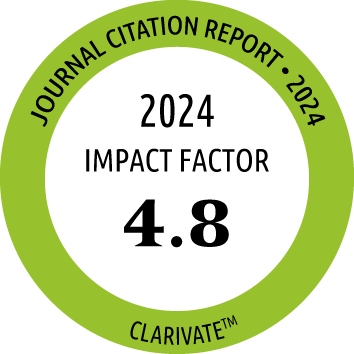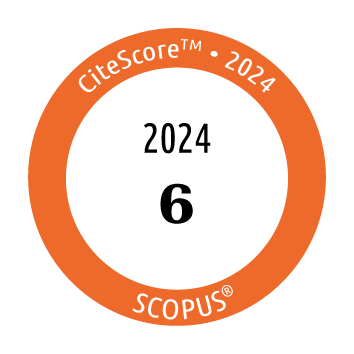Instructions to Authors
The Journal of Investigational Allergology & Clinical Immunology will consider for publication those papers directly related to allergology and clinical and experimental immunopathology.
The journal subscribes to the Uniform Requirements for Manuscripts Submitted to Biomedical Journals (henceforth the Uniform Requirements) of the International Committee of Medical Journal Editors (ICMJE): http://www.icmje.org. Further specifications follow.
JIACI uses the services of a plagiarism screening software that verifies the originality of content submitted before publication. Each manuscript newly submitted to JIACI will be checked in this way
The Journal will comprise the following major sections:
Original Articles. Original research papers in allergy and immunopathology, new forms of therapy for allergic and immune disorders, new applications of diagnostic methods, and clinical and experimental studies on the immunopathogenesis of allergic diseases and immune disorders are welcome. Note that a report of a case series may be considered an original article only if there is an explicit objective that motivated the retrospective or prospective (cohort) study, which should include appropriate statistical treatment of the data.
Advice on appropriate sectioning of original articles can be found in the ICMJE’s Uniform Requirements. In those requirements, it is also recommended that certain study designs follow particular structures for optimum reporting. Links to those specific recommendations can be obtained from the ICMJE website. They are the CONSORT statement for randomized controlled trials, the STARD statement for studies of diagnostic accuracy, the QUOROM statement for systematic reviews and meta-analyses of trials, the STROBE statement for observational studies, and the MOOSE statement for systematic analyses and metaanalyses of observational studies.
Practitioner’s Corner. These short papers, which are intended for rapid publication, follow the same structures as longer original articles described above but do not use subheadings or include an abstract. The text is strictly limited to less than 1000 words (please supply a word count), up to 10 references for the case reports and up to 15 references in the short communications, up to 5 key words, and 1 figure or table. Each figure cannot contain more than one elements (either images or graphics), and the table should not occupy more than half of one A4 page (font, Times New Roman; size, 12, portrait orientation). Extra material can be submitted as online-only supplemental files.
Editorials and Review Articles. Contributions from specialists in the field are requested by the Editors. Unsolicited reviews will be subject to consideration by the Editorial Board or subject to peer review at the Board’s discretion.
Letters to the Editor. Comments on articles published in J Investig Allergol Clin Immunol are welcome. The letter will be sent to the author of the related article, who will have 4 weeks to answer. After the reply, no further correspondence will be accepted. Letters will be reviewed by the Editorial Board or subject to peer review at the Board’s discretion. Letters covering general topics of interest to the readership of the journal are also welcome.
These will follow the same structure as the Case Reports, but the number of authors is limited to five.
Submission of Manuscripts
It is highly recommended to have the language of your manuscript professionally edited before submission.
Manuscripts can be submitted as a Microsoft Word file or a rich text format (RTF) file at the website: http://www.editorialmanager.com/jiaci. File names should not include the corresponding author’s surname.
Each figure should be in a separate document.
Author Assurances. A cover letter requesting review by the Editorial Board for publication in the journal should accompany the manuscript and include a statement by the authors(s) confirming that the manuscript has not been published elsewhere and is not under consideration for publication elsewhere, as well as a statement of consent from all the authors.
Conflicts of interest. Authors must disclose any financial or personal relationship which could result in a conflict of interest with regard to the published article. Please download the ICMJE Form for Disclosure of Potential Conflicts of Interest (http://icmje.org/conflicts-of-interest) fill it out and upload it when submitting your manuscript. Please note that each author should submit a separate form and is responsible for the accuracy and completeness of the submitted information.
All manuscripts accepted for publication remain the property of theJ Investig Allergol Clin Immunol and are subject to copyright restrictions regarding reproduction. Manuscripts published in or submitted to another journal cannot be considered.
Authorship requirements. To be listed as an author, an individual must meet ALL FOUR requirements approved by the International Committee of Medical Journal Editors (ICMJE):
1. Substantial contributions to the conception or design of the work; or the acquisition, analysis, or interpretation of data for the work; AND
2. Drafting the work or revising it critically for important intellectual content; AND
3. Final approval of the version to be published; AND
4. Agreement to be accountable for all aspects of the work in ensuring that questions related to the accuracy or integrity of any part of the work are appropriately investigated and resolved.
Contributions from anyone who does not meet the criteria for authorship should be listed, with permission from the contributor, in an Acknowledgments section. Prior to submitting the article all authors should agree on the order in which their names will be listed in the manuscript.
When a large multi-author group has conducted the work, the group ideally should decide who will be an author before the work is started and confirm who is an author before submitting the manuscript for publication. All members of the group named as authors should meet all four criteria for authorship, including approval of the final manuscript, and they should be able to take public responsibility for the work and should have full confidence in the accuracy and integrity of the work of other group authors. They will also be expected as individuals to complete disclosure forms.
Some large multi-author groups designate authorship by a group name, with or without the names of individuals. When submitting a manuscript authored by a group, the corresponding author should specify the group name if one exists, and clearly identify the group members who can take credit and responsibility for the work as authors. The byline of the article identifies who is directly responsible for the manuscript, and MEDLINE lists as authors whichever names appear on the byline. If the byline includes a group name, MEDLINE will list the names of individual group members who are authors or who are collaborators, if there is a note associated with the byline clearly stating that the individual names are elsewhere in the paper and whether those names are authors or collaborators.
Changes to authorship. Authors are expected to consider carefully the list and order of authors before submitting their manuscript and provide the definitive list of authors at the time of the original submission. Any addition, deletion or rearrangement of author names in the authorship list should be made only before the manuscript has been accepted and only if approved by the journal Editor. To request such a change, the Editor must receive the following from the corresponding author: (a) the reason for the change in author list and (b) written confirmation (e-mail, letter) from all authors that they agree with the addition, removal or rearrangement. In the case of addition or removal of authors, this includes confirmation from the author being added or removed.
Only in exceptional circumstances will the Editor consider the addition, deletion or rearrangement of authors after the manuscript has been accepted. While the Editor considers the request, publication of the manuscript will be suspended. If the manuscript has already been published in an online issue, any requests approved by the Editor will result in a corrigendum.
Please include in the title page a statement of contribution by each author.
All authors should have made substantial contributions to ALL of the following:
1. Substantial contributions to the conception or design of the work; or the acquisition, analysis, or interpretation of data for the work; AND
2. Drafting the work or revising it critically for important intellectual content; AND
3. Final approval of the version to be published; AND
4. Agreement to be accountable for all aspects of the work in ensuring that questions related to the accuracy or integrity of any part of the work are appropriately investigated and resolved.
Preparation of Manuscripts
Manuscripts should follow the ICMJE Uniform Requirements, be typewritten, double-spaced with ample margins on all sides, with numbered pages, and continuous line numbers (i.e., 1, 2, 3 etc.) in the left-hand margin of the manuscript and reference submission items. Do not restart numbering from each page. Line numbering can be added from the File/Page Setup menu of word processing programs and should be continuous throughout the manuscript text file. The word limits for the body of the text, not including abstract, figure legends, or references are as follows: original articles, 3500 words; reviews 5000 (exceptionally up to 7500 words could be accepted); short communications, brief case notes and letters, 1000. (Please supply a word count on the title page.)
Title Page. The first page should contain the full title, a brief running title (not to exceed 40 characters), full name of author(s), institutional affiliation of author(s), and name, mailing address and e-mail of the author to whom all correspondence should be directed. Note the word count and the number of tables and figures. If data have been presented in abstract or poster form at conferences, this information should be noted after the title page, as should funding sources for the study or any author conflicts of interest.
Author affiliations:
If authors have multiple affiliations, each affiliation must be entered as a separate entity. Affiliation numbers must be written in superscript and appear in consecutive order, both in the author list and in the list of affiliations. Please also ensure that all institutions are followed by their city and country.
Example:
Miralles-López JC1,2, Antolín-Amérigo D2,3,4, García-Moguel I2,5,6, Domínguez-Ortega J2,7,8,9, Delgado-Romero J2,10, Quirce S2,7,8,9
1Allergy Department, Hospital General Universitario Reina Sofía, Murcia, Spain
2SEAIC Asthma Committee
3Allergy Department, Hospital Universitario Ramón y Cajal, Madrid, Spain
4Instituto Ramón y Cajal de Investigación Sanitaria (IRYCIS) Madrid, Spain
5Allergy Department, Hospital Universitario 12 de Octubre, Madrid, Spain
6Instituto de Investigación Sanitaria Hospital 12 de Octubre (imas12), Madrid, Spain
7Allergy Department, La Paz University Hospital, Madrid, Spain
8IdiPAZ, Madrid, Spain
9CIBER of Respiratory Diseases (CIBERES), Madrid, Spain
10Allergology Clinical Management Unit, Virgen Macarena Hospital, Seville, Spain
Abstract. Original articles, and reviews require abstracts. The major points of the article should be summarized in to 250 words (original and review articles), in the order of their appearance in the manuscript. Material or facts not cited in the full manuscript should not be included in the abstract. The abstract of an original article should be organized with the following subheadings: Background (optional), Objective(s), Methods (or Material and Methods or Patients and Methods, as appropriate), Results, Conclusion(s). Such structuring is unnecessary for reviews.
Key Words. Three to 8 key words or brief phrases should be included after the abstract for indexing purposes. The Medical Subject Headings used by the US National Library of Medicine’s Index Medicus (MEDLINE) are preferred.
Summary box. Original articles should be accompanied by a summary box that provides answers (maximum 40 words each) to the following questions:
– What do we know about this topic?
– How does this study impact our current understanding and/or clinical management of this topic?
Main Text. For original articles, authors should follow the ICMJE Uniform Requirements for structuring their articles into sections and subsections, as mentioned above.
Tables. Each table should be typed on a separate page after the references. Authors are requested, whenever possible, to construct tables that can be arranged on the page and read in the same direction as the text. Titles should not exceed 2 lines. Information appearing in figures or text should not be included in tables.
Figures. Figures should illustrate important results, and they should be cited in the text. Line artwork (such as graphs) should be submitted as TIFF files, with a minimum resolution of 800 dpi. Other artwork (such as photographs) should be submitted as 250-300 dpi TIFF files. Legends should be included on a separate page in the manuscript, after the references. Figures are published in colour online and black and white in print, so authors must ensure that the colour figure is also intelligible in black and white.
Graphic repository. We recommend using tables and/or figures in all manuscripts in order to facilitate reading and understanding. To help with this task, JIACI has made an image repository available here.
Social Media. We use social networks to increase the diffusion of the articles published in JIACI. We publish key messages on Twitter that summarize the main findings of selected manuscripts. When submitting your manuscript, please provide a key message (max 240 characters) summarizing the main idea conveyed by your study. You can use the hashtags (#) you deem appropriate.
Acknowledgments. When necessary, credit should be given to persons, centers, or foundations that have collaborated in the study. Please also acknowledge help received in preparation of the manuscript (editing services, translation, or other) or statistical analysis. Refer to advice in the ICMJE’s Uniform Requirements.
References. All references should be numbered consecutively throughout the text and enclosed in square brackets placed before punctuation.
The style of citations and references must conform to that of the 'Uniform requirements for manuscripts submitted to biomedical journals' as stated by the International Committee of Medical Journal Editors. List all authors when 6 or fewer; when 7 or more, list the first 6, and add et al after a comma. Authors should consult a recent issue of Journal of Investig Allergol and Clin Immunol and refer to the examples. Please note that there must be a space following the period after the journal name abbreviation; there are no spaces between the year, volume, and page numbers. References to page numbers should be written 123-7 and not 123-127. Page numbers are followed by a period.
References (with the exception of review articles) should be limited to approximately 50 for original articles, up to 15 for the Short Communications and 10 for the Case Reports.
Following are 3 examples of reference presentation forms.
Journals: Jurado-Escobar R, Perkins JR, García-Martín E, Isidoro-García M, Doña I, Torres MJ, et al. Update on the Genetic Basis of Drug Hypersensitivity Reactions. J Investig Allergol Clin Immunol. 2017;27:336-45.
Books: Colloff MJ. Dust Mites. Dordrecht: Springer; 2009.
Chapter in a book: Lindberg M, Matura M. Patch testing. In: Johansen JD, Frosch PJ, Leppoittevin JP, editors. Textbook of Contact Dermatitis. Berlin: Elsevier, Academic Press, 2011; 439-64.
References in Articles - We recommend the use of EndNote or Reference Manager for reference management and formatting.
Supplementary material
As an accompaniment to the main manuscript, authors may submit supplementary materials to be published on line. Please note that these supplementary items are published online exactly as they are submitted; there is no typesetting involved. Please submit the material together with the article and supply a concise and descriptive caption for each file.
Patients’ consent and permission to publish
Studies on patients or volunteers need approval from an ethics committee and informed consent from participants. These should be documented in your paper.
If there is an unavoidable risk of breach of privacy—eg, in a clinical photograph or in case details—the patient’s written consent to publication, or that of the next of kin, must be obtained (document link)
To respect your patient’s privacy, please do not send the consent form to us. Instead, we require you to send a statement signed by yourself confirming that you have obtained consent from the patient using The JIACI patient consent form.
Copyediting and Proofreading
The corresponding author will be contacted by a copyeditor while the manuscript is being prepared for publication, so that the author can approve any modifications suggested. Furthermore, the corresponding author will receive the copyedited manuscript by e-mail with proposed modifications marked on the file, for approval or correction. This process should ensure that the manuscript is both correct and readable, to the author’s satisfaction. If the author is unavailable during this process, publication delay may result.
A minimal number of changes should be necessary on page proofs, which will be sent to the same corresponding author a few weeks later.
Proofs, particularly tables and figures, should be checked against the original manuscript. Proofs not returned in time to meet the publication date will either be rescheduled or published without the authors’ corrections, in which case the Editors do not assume responsibility for any errors that might have been made in typesetting.
Article processing charges
Why does JIACI have article-processing charges?
Open access publishing is not without costs. JIACI defrays these costs through article-processing charges because it does not have subscription charges for its research content. The editorial board instead believes that worldwide, barrier-free, open access to the full text of research articles is in the best interests of the scientific community.
What do the article-processing charges pay for?
Article-processing charges pay for:
- Developing and maintaining electronic tools for peer review and publication.
- Text correction for non-english authors, editing and preparation for online publication.
- Translation of summary into Spanish for non-Spanish authors.
- Securing inclusion in relevant indexing services as soon as possible after publication.
- Securing inclusion in CrossRef, enabling electronic citation in other journals that are available electronically.
How much is JIACI charging?
Original and review articles: 1.700 euros plus taxes (if applicable)
Short Communications: 1.000 euros plus taxes (if applicable)
Case Reports and Letters: 400 euros plus taxes (if applicable) (except those letters referred to recent works published in J Investig Allergol Clin Immunol, which are free of charge).
This payment will be done once the article has been accepted for publication.
When the corresponding author is a member of the SEAIC, a 50% discount will be applied.






